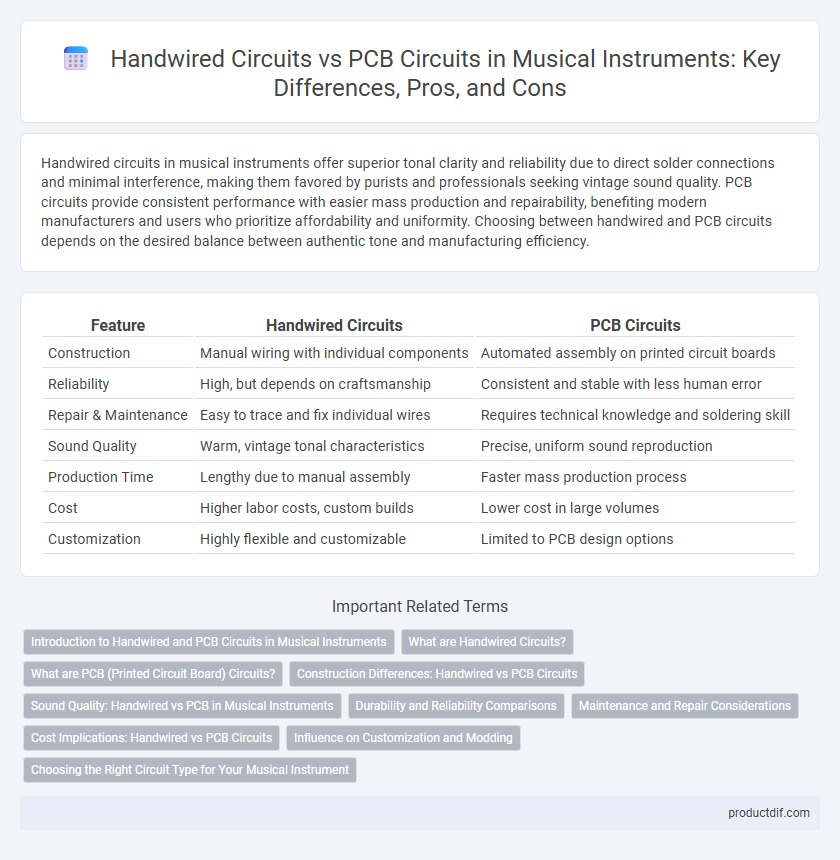Handwired circuits in musical instruments offer superior tonal clarity and reliability due to direct solder connections and minimal interference, making them favored by purists and professionals seeking vintage sound quality. PCB circuits provide consistent performance with easier mass production and repairability, benefiting modern manufacturers and users who prioritize affordability and uniformity. Choosing between handwired and PCB circuits depends on the desired balance between authentic tone and manufacturing efficiency.
Table of Comparison
| Feature | Handwired Circuits | PCB Circuits |
|---|---|---|
| Construction | Manual wiring with individual components | Automated assembly on printed circuit boards |
| Reliability | High, but depends on craftsmanship | Consistent and stable with less human error |
| Repair & Maintenance | Easy to trace and fix individual wires | Requires technical knowledge and soldering skill |
| Sound Quality | Warm, vintage tonal characteristics | Precise, uniform sound reproduction |
| Production Time | Lengthy due to manual assembly | Faster mass production process |
| Cost | Higher labor costs, custom builds | Lower cost in large volumes |
| Customization | Highly flexible and customizable | Limited to PCB design options |
Introduction to Handwired and PCB Circuits in Musical Instruments
Handwired circuits in musical instruments involve manually soldering each component and connection, allowing for customized layouts and easier repairs, often preferred in boutique or vintage-style gear. PCB (Printed Circuit Board) circuits provide a standardized, mass-produced solution with consistent quality and compact design, commonly found in modern instruments and effects pedals. Understanding the pros and cons of handwired versus PCB circuits helps musicians and technicians choose the best option for tone, reliability, and maintenance needs.
What are Handwired Circuits?
Handwired circuits in musical instruments are manually soldered electrical connections created point-to-point without using printed circuit boards (PCBs). This method allows for easier customization, modification, and repair of components such as pickups, switches, and potentiometers in guitars and amplifiers. Handwired circuits often deliver enhanced tonal quality and reliability due to fewer solder joints and shorter wiring paths compared to PCB circuits.
What are PCB (Printed Circuit Board) Circuits?
PCB (Printed Circuit Board) circuits are electronic circuits printed on a non-conductive board using conductive pathways etched from copper sheets. They offer precise, consistent connections and allow for compact, mass-produced designs in musical instruments like amplifiers and effects pedals. PCB circuits improve reliability and reduce assembly time compared to handwired circuits, making them a popular choice in modern instrument manufacturing.
Construction Differences: Handwired vs PCB Circuits
Handwired circuits in musical instruments involve manually soldering components and wires, offering easy customization and straightforward repairs but resulting in a bulkier and less consistent build. PCB (Printed Circuit Board) circuits feature precision-etched pathways on a board, enabling compact, reliable, and uniform construction with higher production efficiency. The choice between handwired and PCB circuits impacts durability, tonal characteristics, and manufacturing scalability.
Sound Quality: Handwired vs PCB in Musical Instruments
Handwired circuits in musical instruments often deliver superior sound quality due to less signal interference and more precise, customizable component placement. PCB circuits provide consistency and reliability but may introduce slight signal degradation and noise due to compact, automated production layouts. Musicians seeking warm, organic tones typically prefer handwired instruments for their enhanced tonal clarity and dynamic response.
Durability and Reliability Comparisons
Handwired circuits in musical instruments offer superior durability due to their robust construction, allowing easier repairs and modifications, which enhances long-term reliability. PCB circuits provide consistent performance with precise, compact design but may suffer from brittle solder joints and trace damage, affecting durability over time. Musicians prioritizing longevity and ease of maintenance often prefer handwired circuits, while those valuing uniformity and mass production lean towards PCB circuits.
Maintenance and Repair Considerations
Handwired circuits in musical instruments offer easier access for maintenance and repairs due to their open construction, allowing technicians to identify and replace faulty components quickly. PCB circuits, while compact and consistent, can be challenging to troubleshoot and repair because of the tightly integrated design and surface-mounted components. Choosing between handwired and PCB circuits impacts long-term serviceability and ease of modifications in guitars, amplifiers, and other musical gear.
Cost Implications: Handwired vs PCB Circuits
Handwired circuits in musical instruments typically incur higher labor costs due to manual assembly and intricate wiring processes, making them more expensive upfront compared to PCB circuits. PCB (Printed Circuit Board) circuits offer cost efficiency through automated production and consistent quality, reducing material waste and assembly time. Both options influence the overall price and maintenance costs, with handwired circuits often favored for vintage tone quality despite the increased expense.
Influence on Customization and Modding
Handwired circuits offer unparalleled flexibility for customization and modding, allowing musicians and technicians to tailor wiring layouts and component choices to specific tonal preferences or repair needs. PCB circuits provide consistency and reliability but limit modification options due to fixed traces and compact designs, making extensive modding more challenging. Customizers prefer handwired circuits for easier access to individual components, facilitating precise adjustments and upgrades in musical instruments like guitars and amplifiers.
Choosing the Right Circuit Type for Your Musical Instrument
Handwired circuits in musical instruments offer superior customization and ease of repair, making them ideal for vintage-style guitars and boutique amplifiers. PCB circuits provide consistent performance, mass-production efficiency, and compact design, suitable for modern instruments requiring reliability and cost-effectiveness. Evaluating factors such as signal integrity, maintenance needs, and budget helps in choosing the right circuit type for optimal musical instrument performance.
Handwired Circuits vs PCB Circuits Infographic

 productdif.com
productdif.com